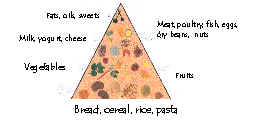|
Go to Reading
List: A Bread Bibliography
Go to Links
 |
| The Egyptian tomb painting above
illustrates how grain cultivation and the 3r's developed side by side. |
| |
|
| |
 |
| |
| |
Making
bread in class is surprisingly easy and a wonderful way to bring all these
lessons to life!
Go to Breadmaking
Go to Basic
Recipe
Top of Page
|
Curriculum
Connections
Breadmaking
& the Curriculum
Breadmaking
is a rich, multi-faceted learning activity that can be connected
to virtually every subject area including language arts, math,
social studies, history, art and science. What follows are some
ideas of how breadmaking and the topic of bread can be linked
to various aspects of the curriculum.
Reading
and Language Arts
In the course of the
breadmaking activity students will read and follow a recipe and
learn wonderful new vocabulary words like yeast, knead,
and dough. It is an activity easily enriched by exposure
to various literary genres including folk tales (The Little
Red Hen), other works of fiction (see the reading list),
poetry, proverbs, and non-fiction. Breadmaking also lends itself
to follow-up writing exercises that could entail a description
of the breadmaking process and an account of what was learned.
|

|
"As
the dough goes into the oven, so the loaves come out."
French Proverb |
| Math
Following
a recipe provides an opportunity to measure volumes and to use arithmetic
operations to make adjustments in the number of loaves produced.
Calculations involving time are also required, since the breadmaking
process takes hours to complete. Some sample problems follow:
- If you have a recipe
for 2 loaves, how much of each ingredient is needed to make 4
loaves? 3? etc.
- You set the dough
to rise for 90 minutes at 10:15. What time should it be ready?
Math problems can be organized around the practical
questions that arise for bakers, farmers , and bread consumers.
Questions like the following can be raised:
- How much does it
cost to produce a loaf of bread (based on the list of ingredients
for your recipe)? What does it cost to make a pound of bread?
- How much would it
be necessary to charge for a loaf of bread in order to make a
profit?
- If so much wheat
(measured in bushels) can be grown per acre (consult agriculture
statistics) how many pounds of wheat are produced (there are 60
pounds per bushel)?
- What costs would
we take into account to figure out how much it costs to grow a
bushel of wheat?
- How many loaves
(or pounds) of bread does your family eat in a week? What is the
price per loaf? per pound? per slice?
-
Which
bread is more expensive: a 1 ounce slice that costs 10¢
or 2 ounce slice that costs 15¢?
   
|


  
|
| Social
Studies and History
With
the vast diversity of bread types from around the world and the
incredible range available in this country (often freshly prepared
in neighborhood bakeries in large urban areas), the possibilities
for follow-up studies about bread and culture are limitless.
- Students
can use their familiarity with Italian bread, bagels, pretzels
(the large, soft kind), pizza, tortillas, rye bread, and pita,
etc. as a springboard to learn about various cultures from around
the world.
- Since
breadmaking depends upon grain, this topic can help increase awareness
of agriculture (even among urban dwellers) and its importance
as a human endeavor.
- Learning
about how grains are grown and how they are prepared as food provides
a window onto the diverse cultures of the world. Particular emphasis
can be placed on wheat, rice, and corn.
- Since
agriculture, milling and breadmaking have all evolved over time,
they are wonderful topics for learning about history.
 In 1664, when the English took New Amsterdam from the Dutch and
renamed it New York, the tallest building on Manhattan Island was
a windmill for grinding grain into flour.
In 1664, when the English took New Amsterdam from the Dutch and
renamed it New York, the tallest building on Manhattan Island was
a windmill for grinding grain into flour.
|




Go to Professor Bread
visits Oklahoma Wheat Country
|
Science
and Technology
The
story of how the need to grind wheat led to the development of watermills,
windmills and today's motorized industrial mills teaches students
about how "necessity is the mother of invention."
The history of agriculture also provides a window onto major technological
and societal changes. Tools like sickles and scythes have been replaced
in the industrialized world by huge combines.
|

|
| One
of the most fascinating facts about the raised breads we enjoy so
much is that one of the necessary ingredients is a living, microscopic
organism called yeast. Breadmaking can serve as a useful introduction
to the world of beneficent microorganisms.
| Bread,
regarded as "The Staff of Life" in Western civilization,
provides a springboard for studying nutrition. Breadmaking
serves as an introduction to whole grain foods that will last
a lifetime!

|
|


|
| Links |
|
www.homebaking.org
Interesting site with plenty of material for educators.
www.kswheat.com
and www.state.ok.us/~wheat
These sites for the Wheat Commission in Kansas and in Oklahoma respectively
contain lots of information about grain and many useful links.
www.hodgsonmill.com
Hodgson Mill provides excellent flour and yeast for our school programs.
Site contains useful information on nutrition and nice collection
of recipes.
|
| |
Go to Reading
List: A Bread Bibliography |











 In 1664, when the English took New Amsterdam from the Dutch and
renamed it New York, the tallest building on Manhattan Island was
a windmill for grinding grain into flour.
In 1664, when the English took New Amsterdam from the Dutch and
renamed it New York, the tallest building on Manhattan Island was
a windmill for grinding grain into flour.





